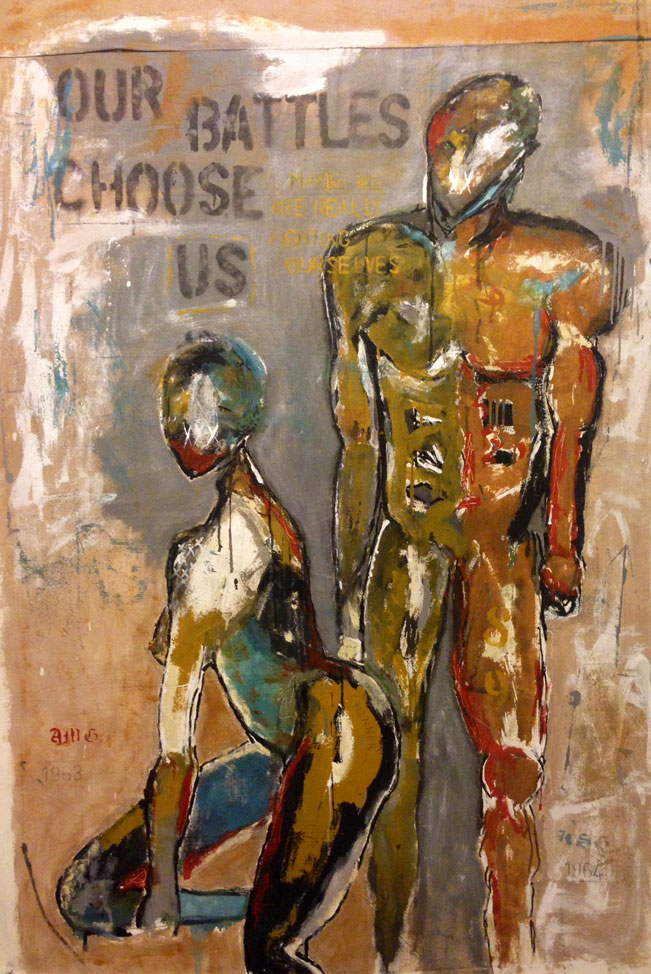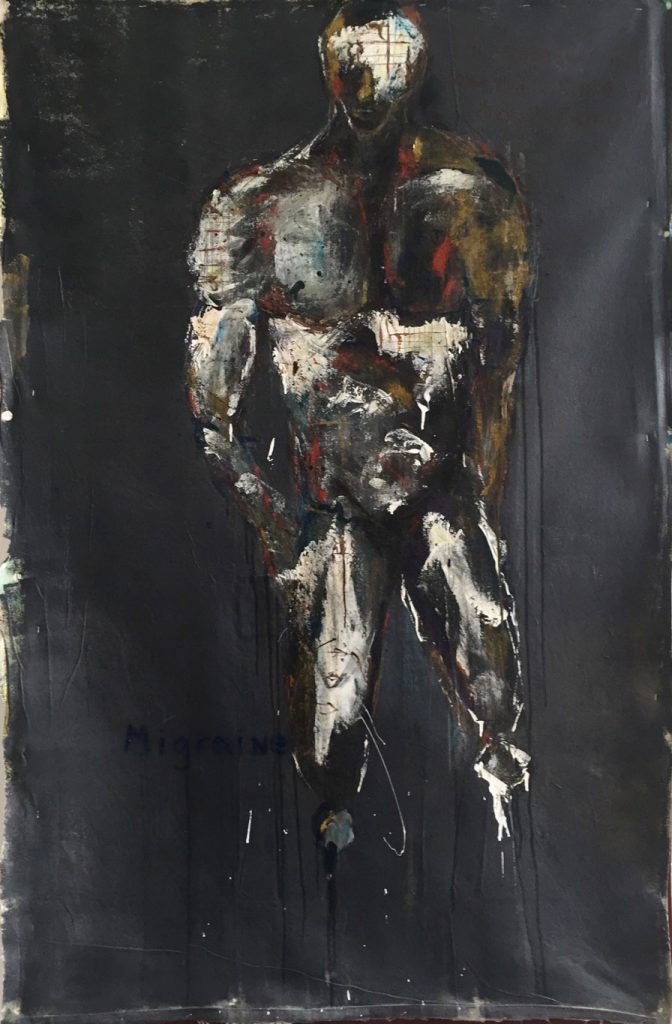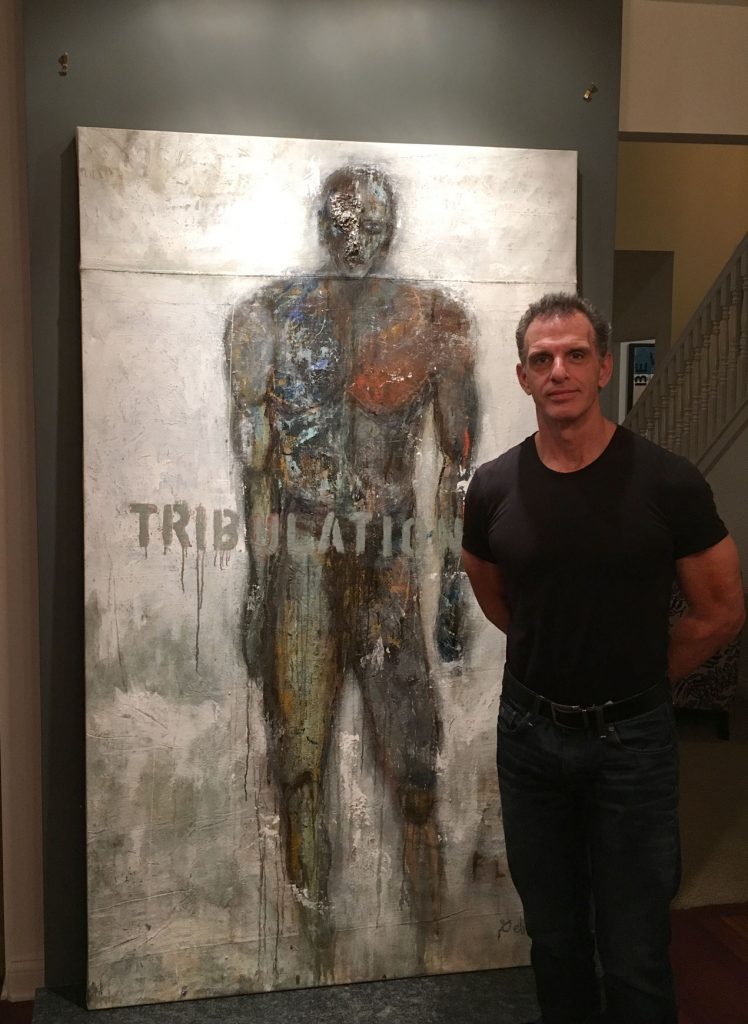Kris Gebhardt knows that physical well-being plays an integral role in an artist’s creativity and career success
By Priscilla Tallman
Kris Gebhardt is a piece of work—literally and figuratively. His art  reflects the winding road that led him to the canvas; his body reflects the daily dedication to training that led him to physical health and mental stamina.
reflects the winding road that led him to the canvas; his body reflects the daily dedication to training that led him to physical health and mental stamina.
“I don’t consider myself an artist but more of a reporter. All my art is tied to my unique life experiences,” says Gebhardt.
Those unique experiences have taken him all over the world and through several phases of his life. Even with setbacks and injuries, his passion for physical fitness and health has never wavered.
A member of the Ball State University football team in the early ’80s, Gebhardt was living the student athlete life until he endured a career-ending knee injury in 1984. Without the structure and discipline collegiate sports offered, his physical and mental game suffered along with his health.
“I ballooned up to 250 pounds,” he says. “I was a washed-up jock.”
But he didn’t wallow for long. Instead, he quickly found himself a job as a member of the personal security team for Tom Monaghan, founder of Domino’s Pizza Corp., and worked himself back into shape. He stayed fit, running five or six miles a day and, at the urging of his boss, started training to become a pizza-franchise owner.
With franchisee training nearing completion, however, he realized he was more into fitness than he was into selling pizza. In 1989, he moved to Indianapolis to begin life as a fitness-equipment sales rep. Again, Gebhardt got restless; he believed it was more important to show people how to use and be successful with the equipment, rather than just sell it.
In 1990, he settled on personal training. “Nobody took fitness seriously back then. It was personal training before there was personal training,” says Gebhardt. However, he took it seriously—so seriously that he put pen to paper and published his first fitness book, Body Mastery, in 1992. Gebhardt is now the author of four books about fitness and health. In 1996, he began training high-profile rock ’n’ roll legend John Mellencamp, who had suffered a heart attack several years earlier. Mellencamp needed a fitness program that would get his heart healthy and his body ready to begin touring. For six years, Gebhardt traveled all over the world on three rock tours with Mellencamp.
 As the years of touring came to a close, Gebhardt developed a passion for art and began experimenting with photography and mixed media. But instead of booking shows in the United States, he quietly started showing his work online and overseas under the name “Kristian” in an effort to gain confidence.
As the years of touring came to a close, Gebhardt developed a passion for art and began experimenting with photography and mixed media. But instead of booking shows in the United States, he quietly started showing his work online and overseas under the name “Kristian” in an effort to gain confidence.
In 2005, Gebhardt booked his first stateside show in Louisville, Kentucky, and then booked several in Miami, New York, and at various private exhibits that could hold his 80-by-84-inch pieces. One of these shows, Art Basel Miami, featured two things with which he was intimately familiar: fitness and rock ’n’ roll.
“All art is physically demanding; if you are physically clear, it stirs creativity. If someone comes in to buy a piece of art, they are buying you,” says Gebhardt. It’s no surprise, then, that Gebhardt combined his varied life experiences and made the natural connection between physical and mental fitness and selling art at art shows. Selling creativity, Gebhardt believes, takes stamina. Artists’ financial investments in their booths, their creativity, their travel, and their work should also reflect their investment in their health.
A neglect of one’s physical self, Gebhardt says, reflects in the artist’s presentation of his or her work. But the converse is true, as well: Being fit and having the mental and physical stamina to work big art shows gives the artist an edge. An edge, Gebhardt believes, that is available to anyone who chooses it.
“Our outer shell is a reflection of our inner being, how you are feeling, and the painting you give to the world,” says Gebhardt.
As an artist and a businessman, Gebhardt believes that a daily training regimen is vital for producing and selling his best work. With art shows and gallery openings around the nation, Gebhardt says the following things can affect how you sell art and your overall experience at any art show.
Nutrition: “Don’t leave your food up to someone else. Take your nutrition into your own hands,” says Gebhardt. As soon as he and his wife, Angela, arrive in the city where they will be showing art for the week, they hit the deli. The couple brings a small cooler with snacks, snack bars, sandwiches, and waters for the day and restocks each morning. Gebhardt’s hard rule is “no fast food.” If you plan your meals beforehand, eliminating fast food is easy. Remember that the best food at a venue is usually gone by noon, so having a plan for nutrition is paramount.
Hydration: Pack water to bring along and drink plenty of it throughout the day. The venue may sell juice drinks, but they are full of sugar and will leave you depleted of energy in the long run. If you are well-hydrated, you will likely need to take some bathroom breaks. Use these breaks to stretch your legs, take a quick walk around the venue, and get your blood flowing.
Exercise: A full day of travel can be rough on your body. “On the day you arrive, go right to the gym. It’s critical that you exercise every day; it helps with jet lag, revives [you], and gets blood going to move out toxins,” says Gebhardt. Most hotels offer enough equipment for you to get daily exercise, and, if not, you can always take a brisk walk to get your heart pumping. Daily movement and exercise are also good for your posture. Good posture communicates confidence, and confidence helps sell art. Poor posture and visible exhaustion may cause you to miss an opportunity.
Weight Training: “Moving blood brings oxygen and nutrients to parts of the body. Blood is life,” says Gebhardt. Weight training creates demand on the body to move blood to your muscles, and your muscles in turn move the blood throughout your body. Weight training releases endorphins and oxygenates the body and mind. In essence, it clears out the cobwebs and helps you focus your mind and body.
Mental Stamina: “Mental stamina is a byproduct of [your] focus on the whole body,” says Gebhardt. When you combine nutrition, hydration, exercise, and weight training, you will have a clearer mind and more confidence to deal with the emotions inherent in exhibiting and selling art. When you go up against the biggest and best artists in your space, people will judge you on what you create. If your mental game is off, it may show up in your posture or energy levels. Having a fitness and nutrition regimen will help your body recover from physically and emotionally draining days and keep you energized longer.
Gebhardt admits that it’s emotionally demanding and mentally taxing to put your career on the line at a big art show and expose your creativity. But throughout his life, he’s seen the ability of health and fitness to counterbalance the intense and varied feelings that come with the territory of selling art.
Though he no longer trains rock stars and billionaire business moguls, Gebhardt is still passionate about getting his message to those who are willing to make a change. You may experience several career paths or experiences, but you have only one body. “Keep going for it; you have to celebrate these things. [My art] looks like my life. Our scars are so important; my career is full of them,” says Gebhardt.



2 Comments
Like his work, reminds me a bit of Frances Bacon in a way….
This is fantastic. I agree 100 percent. The Artist is never separate from the art he/she creates. Art is a holistic journey and the art the artist creates as a reflection of who they are on the inside. Really cool to see other artists aware of and speaking about this dimension of art creation!
Grateful for this article – thanks for posting.